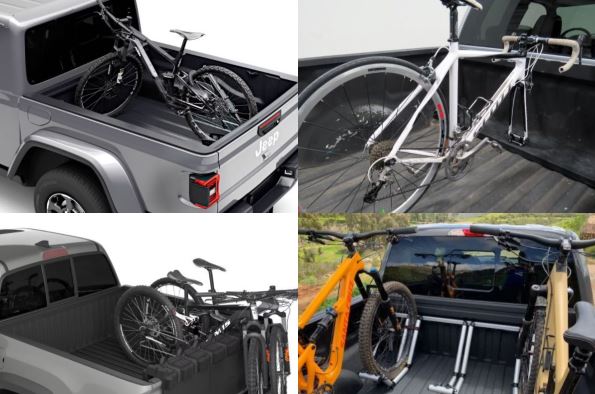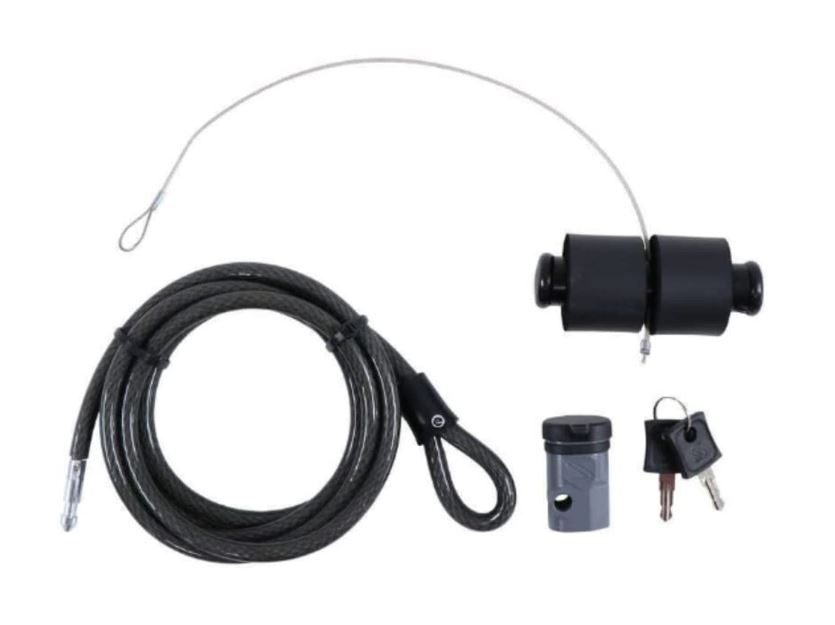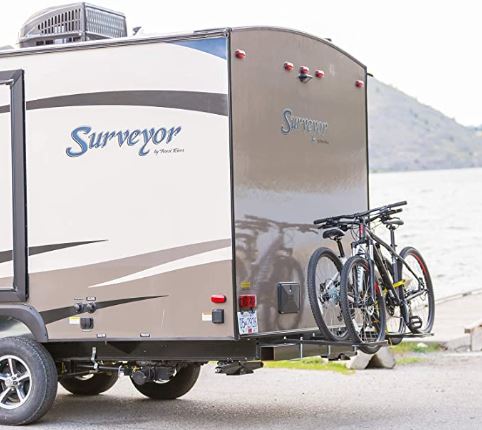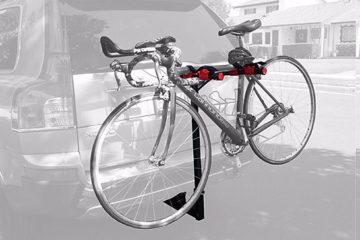Types of Bike Racks: Hitch, Hitchless & Other Car Mounts
There are different types of bike racks in the market but they are all made to safely carry bikes on a vehicle with some additional features for the convenience of users. If it is your first time buying a bike rack, you might be confused about the right rack type to go for.
Well, all racks cannot be suitable for you so you need to consider a few things before you pick a rack for yourself. For instance, if your vehicle does not have a hitch receiver or roof rails, you might have to buy them for a hitch and roof car mount for bike, respectively.
Also, if you have a limited budget you might want to look for an economical trunk or spare tire racks. But are they compatible with your vehicle? In this article, you will find all about the different types of bike racks, their pros and cons, load capacity, price range, and factors that need to be considered before making the final buying decision.
Comparing different types of bike racks
Almost all biking enthusiasts want to explore new tracks, terrains, and roads. So having a compatible bike rack ensures that you are able to travel long distances with your bikes strapped up safely. It is not easy to select a bike rack though, as a variety of factors need to be considered before one is able to find a suitable one: In your journey to find the best suitable bike rack start off by looking at the below table which has an overall summary of the major features of different types of bike racks.
| Hitch | Roof | Trunk | Spare tire | Truck bed | Tailgate | |
| Bike capacity | 1-6 | 1-2 | 1-4 | 1-3 | 1-5 | 1-7 |
| Weight of racks | 20-50lb | 7-17lb | 2-28lb | 10-20lb | 4-30lb | 6-10lb |
| Price range | $80-$1100 | $250-$330 | $33-$480 | $80-$390 | $30-$320 | $90-$250 |
| Additional requirements | Hitch receiver | Roof rails and crossbars | Top tube adapter | Rear-mounted spare tire | None | None |
| Load capacity (per bike) | 40-70lb | 40-45lb | 30-35lb | 30-35lb | No limit | No limit |
What are the different types of car mounts for bikes out there?
While some bike racks are cheap, they might not be compatible with your car or your biking requirements. Hence it is essential to be aware of all the available options. In our experience, there is no one best bike rack but the best types of bike racks are those which are best suited to your specific vehicle and biking requirements. The major types are mentioned below along with their pros and cons.
Hitch mount bike rack | Best for regular usage and convenience

Hitch bike racks are a great option if you want to travel with relatively heavy bikes or e-bikes. These racks are the easiest to use in terms of loading and unloading bikes and can be installed easily. There are two sub-types of these bike racks, platform, and hanging-style bike racks.
Platform hitch bike racks are an excellent option if you want to carry heavier bicycles. The attachments for this are slightly closer to the roof bike racks. The bike completely rests on the wheel trays with only the wheels coming in contact. While hanging-style racks hang the bikes through the frame’s top tube and are a bit similar to the trunk bike racks. These racks are relatively more affordable.
These types of bike racks are especially recommended if you have a receiver already installed on your vehicle. There are basically two types of hitches class I and III. Class l is usually found on regular cars while class lll is found on bigger SUVs or trucks. You can also purchase a trailer hitch separately to install on your vehicle.
A hitch car mount for bike would either be compatible with 1 ½” hitch receivers or 2” hitch receivers. So before you buy a rack, you have to be sure about the size of your car hitch. Hitch bike racks are compatible with most bikes including e-bikes, mountain bikes, fat bikes, etc.
The price of these types of bike racks varies greatly depending on the number of bikes and brands you are purchasing. You can get a hitch bike rack for a single bike, or multiple bikes. There are some great 4-bike hitch racks at a wide range of prices and some vertical hitch bike racks for up to 6 bikes.
Pros and Cons of hitch bike rack
These racks are best to avoid any scratch or damage to the vehicle because they do not come in contact. One also does not need to detach the wheels or any other parts of the bike to attach it. Simply place the bike on the platform and secure it through the integrated locking features in most hitch racks.
These can become an expensive choice if the hitch is already not there with the vehicle. The driver’s view is also limited because of the placement of these racks and how the bikes install onto them. These types of bike racks also increase the length of the vehicle which can be a problem during parking.
Roof mount bike rack for car | Best looking bike racks

The roof car mount for bike attaches to the roof racks of your vehicle. If you already have one installed on the top of your car, your only concern should be the compatibility of your roof rack with the bike rack. In case you do not have a car roof rack, then you would have to purchase that separately which would mean that the complete system could become very pricey.
The sub-type of roof bike racks include frame mount, fork mount, and wheel mount roof racks. These types of bike racks differ on the basis of the installation. In a frame mount roof rack, the rack attaches to the frame while in the fork and wheel mount racks, the fork and wheels come directly in contact with the rack, respectively.
We quickly compared roof bike racks offered by a leading manufacturer. Thule bike roof racks come in a range from $230 to almost $500. The most expensive one is a Tandem (which we suspect isn’t the biggest seller anyways), while the rest are priced below $300. Basically, the range depends on the sub-type of the rack.
In terms of weight, these types of bike racks weigh around 7 to 17 pounds wherein the maximum capacity is 44 pounds for the Thule UpRide (their top-rated product). Additionally, it is pertinent to note that one roof car mount for bike would accommodate one bike, so one carrier for each bike.
Pros and cons of roof bike rack
The main advantage of a roof rack is that it leaves the entire interior space of your car at your disposal. You can use all the remaining space below the roof to carry other items you need for traveling. Other advantages include the lock system it offers and the ability to carry 4 bikes simultaneously.
Most of these types of bike racks have tilt-away or swing-away features to let you access the trunk or hatch. Some of them also have integrated folding ramps for easily loading heavy bikes such as electric bikes.
The downside however is all the additional requirements you will need to make up for this car mount for bike, such as the car rack, the cradles, rails, and the mountings. Furthermore, it is not particularly easy to place a bike on top of a car, as it is more or less a two-person job.
Also, these types of bike racks can cause difficulty parking in garages due to the height, strong wind resistance, and vehicle weight requirements. Normally these are single bike racks and it’s pricey to get more than one bike rack installed on your vehicle roof.
Trunk mount bike rack for car | Most economical type

The most economical option per bike is the trunk bike rack. These types of bike racks are designed to work without any tow bar or even a car roof rack. The bike rack simply takes the support from the car’s trunk or the hatch door and in the case of a sedan, one end of the rack settles just above the bumper and the other end on the trunk.
Apart from the elbows of the rack, there are numerous straps that ensure that the rack position does not change on the car. These racks have two arms with individual cradles and the bikes rest on them and are fastened with rubber straps.
As compared to the types of bike racks mentioned above, trunk bike racks are the most cost-effective. We reviewed the best trunk bike racks and came to find that the majority of these racks can hold 1 to 4 bikes and range in price from $33 to $480 depending on the features.
These racks once installed are easy to work with because they are lightweight and do not require assembly. Some trunk bike racks such as Thule Outway have an option of carrying bikes on a platform. Please have a look at our detailed guide on How to put a bike on a bike rack?
Pros and cons of trunk bike rack
The main advantage of the trunk car mount for bike is that they are the most economical per bike. On average 2-bike hitch rack would cost you more than $400 while a 2-bike trunk bike rack can be purchased for under $200 with the cheapest rack costing only around $33.
These types of bike racks are very easy to install and can be folded after use. They are also lightweight yet fairly sturdy for long-term use. Most of these racks have a coating that protects them from extreme weather damage.
The biggest issue with trunk bike racks is that they make the trunk inaccessible. So on a long road trip, you have to ensure everything need you to carry in the trunk initially is secured inside, and only after that do you install the rack.
Also if improperly installed the trunk bike rack can scratch your car. The final weakness of these racks is that since they are easily accessible (unlike car roof racks), you are more prone to bike theft. And these types of bike racks usually lack an integrated locking system.
Spare tire mount bike rack

You might ride a jeep or any other vehicle with a spare tire for recreation or even urban commuting. A spare tire car mount for bike is a great option to carry bikes places. These types of bike racks are completely different from a roof bike rack but similar to a trunk bike rack or a hitch bike rack.
The difference is while a hitch connects the rack to a hitch receiver on the vehicle, the spare tire bike rack connects to the spare tire. These racks are designed for specific vehicles you need to be sure before purchasing one that it would fit properly. Also, these racks are light in weight as compared to hitch racks.
Most spare tire bike racks employ the same installation mechanism as trunk bike racks. They have straps that go around the spare tire and are fastened to keep the rack in position. And due to this installation style, these types of bike racks are unable to carry very heavy bikes.
Based on our review of the best spare tire bike racks, they accommodate 1-3 bikes and can be bought in the range of $80-$390. They do not require a hitch receiver or roof rails but since they are hanging-style bikes, you might need a top tube adapter for some bikes such as women’s and kid’s bikes.
Pros and cons of spare tire bike rack
It is easier to load bikes on spare tire racks compared to roof bike racks. These types of bike racks are reasonably priced as compared to hitch and roof bike racks and usually, they do not block the rearview camera. Some spare tire racks are RV-approved and they do not halt access to the back door.
Most of the spare tire bike racks would only accommodate a maximum of two bikes. Some of these racks are not very stable which leads to the swaying of the front tire. Also, you have to keep a check on the straps getting loose on a road trip.
Truck mount bike rack

Conventional car mount for bike are either designed for a car’s roof, trunk, or hitch. They are not designed to fit a truck that has a short but higher roof and does not have a trunk (normally). Also since trucks have more space on their bed it makes perfect sense to utilize that space for transporting your bike.
There are different types of truck bed bike racks as well which vary amongst themselves on the design features and number of bikes they can manage. These racks have high bike capacity so if you own multiple bikes, you can fit them in the truck bed according to their size.
These types of bike racks are installed into the bed of the truck, side rails on the bed, or on the tailgate. The ones that are installed in the bed, are either wheel mounts or fork mounts for which, you have to remove the front wheel on your bikes.
However, tailgate pads are the easiest to use. You do not need to remove the wheels on your bike, and you can carry up to 7 bikes if you own a large truck. Installing these types of bike racks is a breeze and they are also economical if you consider the per-bike cost.

Pros and cons of truck mount bike rack
Truck bike racks do not extend the length or height of the vehicles which means that you can drive easily. Most of these racks especially tailgate racks and pipeline racks have high bike-carrying capacities so you can haul multiple bikes of any size. Also, these racks are way more economical as compared to hitch and roof bike racks.
But a downside of using these types of bike racks is that you cannot carry other stuff on your truck bed especially if you want to load multiple bikes. Some of these racks also block the rear view due to the bike heights. But that will not be a problem for fork mount racks. However, installing a fork mount rack usually requires drilling.
How do I choose the right bike rack?
You need to ask yourself the following question before you decide on the type of rack to go for.
- What type of bike(s) do you need to carry?
The right car mount for bike can be determined by considering the geometry and weight of the bike. Some bike racks hold the bikes through their frame and they are only compatible with certain shapes. Moreover, different types of bike racks have different load capacities so you need to choose the one that can carry the weight of your bike(s).
- What type of bike racks are compatible with my vehicle?
Not all bike racks are compatible with every vehicle. Hitch bike racks are only compatible with vehicles that have the required size hitch receiver, roof bike racks are compatible with vehicles that have roof rails, and spare tire bike racks are compatible with vehicles that have a spare wheel mounted on the back.
- How much am I willing to spend on a bike rack?
Many types of bike racks are available at a range of prices so you should look for racks that can be bought within your budget. You can purchase a 2-bike trunk car mount for bike at around $35 or a 2-bike hitch rack with better features at $1000 so it all depends on your requirements. Generally, trunk bike racks are the most economical.
- How often would I be using that bike rack?
Depending on how often you have to use your bike rack, you should look for racks that can be easily installed and uninstalled or have folding features so you can leave them on the vehicle. If you use them frequently, look for racks that are quickly mounted and lightweight and if they are heavy, it is better to have a folding feature.
What are the different bike rack manufacturers?
There is high competition among the brands that make different types of bike racks. Some of the top bike rack manufacturers offer distinct features or value to their customers. The most popular manufacturers are Yakima, Thule, and Kuat. They have a number of premium quality racks that are irreplaceable.
Saris and Allen Sports have many trunk and hitch car mount for bikes with great features at a lower price. Other than that, Hollywood racks, Swagman, and Rockymounts, also have a variety of bike racks that meet the requirements of different bike enthusiasts who own vans, RVs, SUVs, or hatchbacks. Pipeline racks are also popular for their truck bed bike racks.
How to transport the bike without a rack?
In case you are wondering how to transport a bike without a car mount for bike. That would again depend on the type of bike you are carrying and the type of vehicle you are traveling on. You can either fit your bike somehow in the car or build a DIY bike rack.
It’s easy to manage in a sedan if you are not carrying any other luggage in the cargo trunk. All you need to do is take both wheels off (easier if you have skewers) and first fit the frame then place both wheels on top of it in the trunk. The frame usually does fit in the trunk and rarely does one have to lower down the seat post in order to fit.
The case is similar for bigger vehicles such as SUVs and jeeps. But in the case of a hatchback, you would have to use the space above the rear seats leaving you with no space for rear passengers.
How to transport the bike without a rack
In case you are wondering how to transport a bike without a rack. That would again depend on the type of bike you are carrying and the type of vehicle you are traveling on. It’s easy to manage in a sedan if you are not carrying any other luggage in the cargo trunk. All you need to do is take both wheels off (easier if you have skewers) and first fit the frame then place both wheels on top of it in the trunk. The frame usually does fit in the trunk and rarely does one have to lower down the seat post in order to fit. The case is similar for bigger vehicles such as SUVs and jeeps. But in the case of a hatchback, you would have to use the space above the rear seats leaving you with no space for rear passengers.
How much weight can a bike rack hold?
A bike rack can hold weight depending on the type of carrier. But keep in mind the car’s limit is more important as compared to the limit prescribed by bike rack manufacturers
- Roof bike: Maximum recommended weight for one roof bike carrier is 44 pounds.
- Trunk Bike Rack: Maximum recommended weight for a Trunk bike rack is 100 pounds.
- Hitch Bike Rack: Maximum recommended weight for the Hitch bike rack is 150 pounds.
Conclusion – The best type of bike racks
Best types of bike racks? Again it all falls down to your biking requirements and the vehicle you are driving. But the basics are that the most economical per bike would be a trunk or hanging bike rack which does not require any external attachments to it, the most convenient is the hitch bike rack where you don’t have to follow complicated instructions on installing the racks and the most out of the way rack is the roof rack where ensures that the bike does not come in between your way to the trunk or back door.
FAQs about car mount for bike
How to install bike mount for car?
Bike mounts or bike racks have different installation procedures. Some types of bike racks are mounted on the trunk or hatch through the integrated bike rack straps, some have a hitch that fits into the hitch receiver on the vehicle, while others may be mounted on the roof, truck bed, or spare tire on the rear side of the car.
How-to put-on bike mount for car?
You can put on a bike mount on the roof of your car by attaching it to the roof rails or suction cups. These racks usually require assembly. However, if you want to mount it on the rear of your car, you can either strap it to the trunk or hatch, or you can fit the hitch bike mount into the hitch receiver. Apart from that, tailgate pads just have to be spread and tied down on the tailgate of the truck while truck bed bike racks have varying mounting styles.
How to put a bike on a trunk bike rack?
You can place a bike on the trunk bike by first ensuring the bike rack is tightly fixed, selecting the right direction of the bike, placing the bike’s top tube on the cradles, and finally fastening all straps on the bike rack. You can find the detailed process of How to put a bike on a bike rack?

How to bike mount for car roof?
The majority of the time, roof bike racks demand a level of assembly before use. To begin with, confirm that your car has roof rails or crossbars because these types of bike racks are mounted on them. Rails can be purchased separately if your vehicle doe not have them.
How do you mount a female bike on a bike rack for a car?
Women’s bikes are shorter in height and have lower-top tubes. For mounting these bikes on a hanging-style bike rack, you would have to purchase an adapter bar, install it on your bike, and then hang your bike on the bike cradles through that adapter bar.
What are hitchless bike racks?
Hitchless bike racks do not mount on the car through a hitch so you do not have to install a hitch receiver on your car. These racks can be mounted on the car trunk, hatchback, or roof. Hitchless bike racks are reasonably priced as compared to hitch bike racks and are available in great variety. Find out the best hitchless bike racks for SUVs.
What kind of bike rack is easiest to use?
Platform-style hitch bike racks are the easiest to use if you own heavier bikes. These types of bike racks are closer to the ground so you do not have to lift your bikes much. The bikes can be easily secured on the wheel trays and you do not have to remove the front tires of bikes.
Which bike holder is best?
No bike rack is perfect for all. The best bike holder or car mount for bike depends on your specific requirements. If your car has a hitch receiver, and you own multiple heavy bikes, then you might want to look for a 4-bike hitch rack. However, if you own a truck and travel with your family along with 4-7 bikes, a tailgate pad would be the best option.
What is a tray style bike rack?
The platform-style racks are also known as tray-style bike racks. These types of bike racks are usually mounted through the hitch and have the ability to carry high loads. They are the safest for valuable bikes because they do not have any frame contact. Some trunk bike racks such as Thule Outway are also tray style.

How much weight can a bike rack hold?
The weight-carrying capacity of a car mount for bike depends on its type. Generally, hitch bike racks have the highest load-carrying capacities i.e., a bike up to 70lb. Roof bike racks carry up to 44lb bikes while the trunk and spare tire racks carry 30-35lbs bikes.
How much do different bike racks cost?
All the different types of bike racks are available at a range of prices. You can get a rack below $40 and you would also come across racks at around $1000. There are no fixed prices because there are a lot of factors that affect the price of a bike rack such as brand value and offered features. Find out the costs of trunk, hitch, and roof bike racks.
How can I protect the bike rack and the bike on it?
You can use trunk bike rack locks to lock the bike rack and the bike, hitch bike locks, one key system cable locks, and other different mechanisms for protecting your bike racks. Both the trunk rack locks and passive strap locks should work in the case of a hitch bike rack as well. The difference is that in the case of the hitch bike rack, you might need a longer cable. You can use a bungee cord cable to secure the frame of the bike and for further safety, you can also pass it through the wheels to eventually bring the other end of the cable into the car.

Other types of bike racks
There are some other types of bike racks specifically designed for certain vehicles or bikes

What should i consider before purchasing a bike rack?
- Is it compatible with your biking requirements? (number of bikes your want to carry, type of bike, size, etc.)
- Is it compatible with your vehicle? (SUV, Hatchback, Car, Truck, Trailer, RV, Jeep, etc.)
- Is it affordable, safe, and durable?



0 Comments